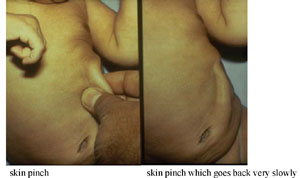
All sick children that come to your health facility should be checked for diarrhoea.
You need to assess the following:
The table below sets out the signs you need to ask about and look for when assessing a child who has diarrhoea.
| Does the child have diarrhoea? IF YES ASK: | LOOK AND FEEL |
|---|---|
|
● For how long? ● Is there blood in the stool? |
● Look at the child’s general condition. Is the child: - Lethargic or unconscious? - Restless and irritable? - Look for sunken eyes. ● Offer the child fluid. Is the child: - Not able to drink or drinking poorly? - Drinking eagerly, thirsty? ● Pinch the skin of the abdomen. Does it go back: - Very slowly (longer than two seconds)? - Slowly? |
You will now look at the steps for assessing diarrhoea in a child in more detail.
Next, you need to check the child for signs of dehydration.
A child who becomes dehydrated is at first restless and irritable. If dehydration continues, the child becomes lethargic or unconscious. As the child’s body loses fluids, the eyes may look sunken. When pinched, the skin will go back slowly or very slowly. To assess whether the child is dehydrated, and how seriously, you need to look and feel for the following signs.
When you checked for general danger signs, you checked to see if the child was lethargic or unconscious. If the child is lethargic or unconscious, he has a general danger sign. Remember to use this general danger sign when you classify and record the child’s diarrhoea.
If a child is lethargic or unconscious this is a general danger sign.
The sign restless and irritable is present if the child is restless and irritable all the time or every time he is touched and handled. If an infant or child is calm when breastfeeding, but again becomes restless and irritable when breastfeeding stops, he has the sign ‘restless and irritable’. However, many children are upset just because they are in the health facility and in unfamiliar surroundings. Usually these children can be consoled and calmed. They do not have the sign ‘restless and irritable’.
The photographs in Figure A show you how to do the skin pinch test and what the child’s skin looks like when the skin pinch does not go back immediately.
The skin pinch test is not always an accurate sign of dehydration because in a child with severe malnutrition, the skin may go back slowly even if the child is not dehydrated. In an overweight child, or a child with oedema, the skin may go back immediately even if the child is dehydrated. However even though skin pinch is less reliable in these children, you should still use it to classify the child's dehydration.

What are the possible assessments you might make for a child with diarrhoea?
Show answer
You might assess the child for dehydration. If the child has had diarrhoea for 14 days or longer you would assess persistent diarrhoea, and if you see blood in the stool or if the mother tells you that there has been blood in the stool, you would record that the child might have dysentery.
How can you assess whether a child has dehydration?
Show answer
If the child is irritable and restless, not able to drink or drinks poorly, these are all signs of dehydration. Another sign is a skin pinch that returns slowly or very slowly. You should also remember that if a child is lethargic or unconscious this is one of the general danger signs as well as a possible sign of dehydration.
Following your assessment of the child for diarrhoea and dehydration, your next step is to classify the diarrhoea. How you do this will depend on the age of the child, and you are going to look at this next.